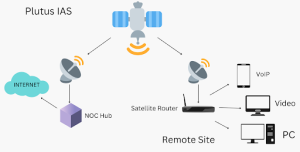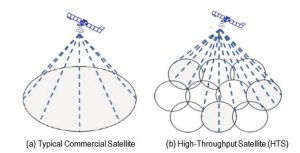03 Oct Satellite Internet: India’s first High-Throughput Satellite(HTS) broadband service launched
Satellite Internet
The topic is based on Satellite Internet. It talks about how “Satellite Internet: India’s first High-Throughput Satellite(HTS) broadband service launched” impacts The Science and Technology of India.
CONTEXT
India’s first High-Throughput Satellite(HTS) broadband service was recently launched by Hughes Communications India (HCI), a satellite internet service provider with the help of the Indian Space Research Organization (ISRO). In another significant step, Reliance has launched a joint venture (JV) with European satellite-based broadband service company SES to explore its space.
WHAT IS SATELLITE INTERNET
In this Internet process, wireless internet is beamed down from communication satellites orbiting the Earth. It does not make use of wires. Satellites are placed either in Lower Earth Orbit(LEO) or geostationary orbit(GEO). Internet service providers send an internet signal to a satellite located in space. This signal is then sent back to the user which is captured by a satellite dish that is connected to the modem of the user.

Pic: SATELLITE INTERNET
WHAT IS High-Throughput Satellite(HTS)
HTS is a communication satellite that provides more throughput than conventional communication satellites (Fixed Satellite Service). By utilizing the same amount of orbital spectrum as FSS, HTS provides a greater capacity than FSS and thus not only increases efficiency but leads to decreased cost. FSS generally uses a broad single beam to cover a vast expanse of geographical area. This reduces its spectral efficiency. HTS, on the other hand, uses a large number of “spot beams” with smaller footprints, each covering a smaller area. Therefore, each beam will provide a separate signal, and hence the overall system will have improved spectral efficiency, leading to enhanced speed, higher data processing, and better transfer capacity.

Pic: High Throughput Satellite
BENEFITS of SATELLITE INTERNET
- Easy availability: It has the potential to reach the remotest parts of the country. It can be accessed from any part of the world even in difficult geographical terrains. With about 37% of the global population still without the internet, there is a need to make the internet available and accessible.
- Better Reliability: Chances of terrestrial internet networks failing are more than satellite internet.
- Higher Speed: It is faster than traditional network internet. On average, It is 10 to 35 times faster than the conventional internet. This leads to more efficiency.
- Lower costs: Since it does not require laying fiber networks or putting up towers, it is relatively cheaper.
- Lower Environmental damage: Laying optical fibers requires digging up soil, laying the groundwork, and constructing towers. It does not require this and hence is less invasive for the environment.
- Faster deployment: satellite antennas can be easily installed and deployment takes very less time compared to traditional internet networks.
- Security: It is safer and more secure due to better encryption technology.
- CHALLENGES:
- High Latency: In the case of SI, data is first sent to space which is then sent to the internet service provider and back again to the device which causes high latency. Satellite internet data travels a long way as satellites are positioned 22,000 miles above the earth. As the distance required to be covered for data increases, the latency also increases.
- Susceptible to bad weather: The signal path of satellite internet is affected by the weather condition. Storms, rains, and high-speed wind may lead to poor signal and the internet may not reach the Earth.
- Initial installation is expensive: Designing, building, and launching satellites in space is an expensive process. Thus, the cost is relatively higher compared to traditional internet.
- Prone to obstruction: Even minor obstructions can block its signals. Trees and buildings can block satellite signals.
- Space Debris: It can increase space debris or space junk. These are defunct human-made objects in space in the Earth’s orbit that no longer serve a useful purpose. This can lead to Kessler syndrome which is a self-sustaining cascading collision of space debris that can lead to Earth’s orbit becoming unusable.
WAY AHEAD
It can be used to provide access to the internet to the whole world. It can bridge the digital divide, help rural areas get access to telemedicine and distance learning, and help India develop at a faster pace. The drawbacks must be addressed and outer space is utilized responsibly. The draft Indian Spacecom Policy, 2020 which will provide a framework for companies operating in the space come domain to launch space broadband services in India via the low-earth orbit (LEO) and medium-earth orbit (MEO) is a much-needed step to ensure the regulation of it.
SOURCES
Current Affairs for UPSC Examination
Nowadays current affairs are part and parcel of the UPSC examination. To gain general knowledge, Daily Current affairs play very important roles. If you are preparing for the IAS examination, you should read IAS’s current affairs regularly. To pass any competitive examination, every aspirant has to go through and commit to memory important current affairs.
Plutus IAS servers top 10 current affairs every day. It also provides one of the best coaching for anthropology optional. We use to serve you all new current affairs from our site free of cost. Read daily current affairs for UPSC examination from us. Because you get the precise and the best current affairs for UPSC, IAS, and SSC examinations. So habituate to read the best daily current affairs for UPSC from us.
Download PDF:



No Comments